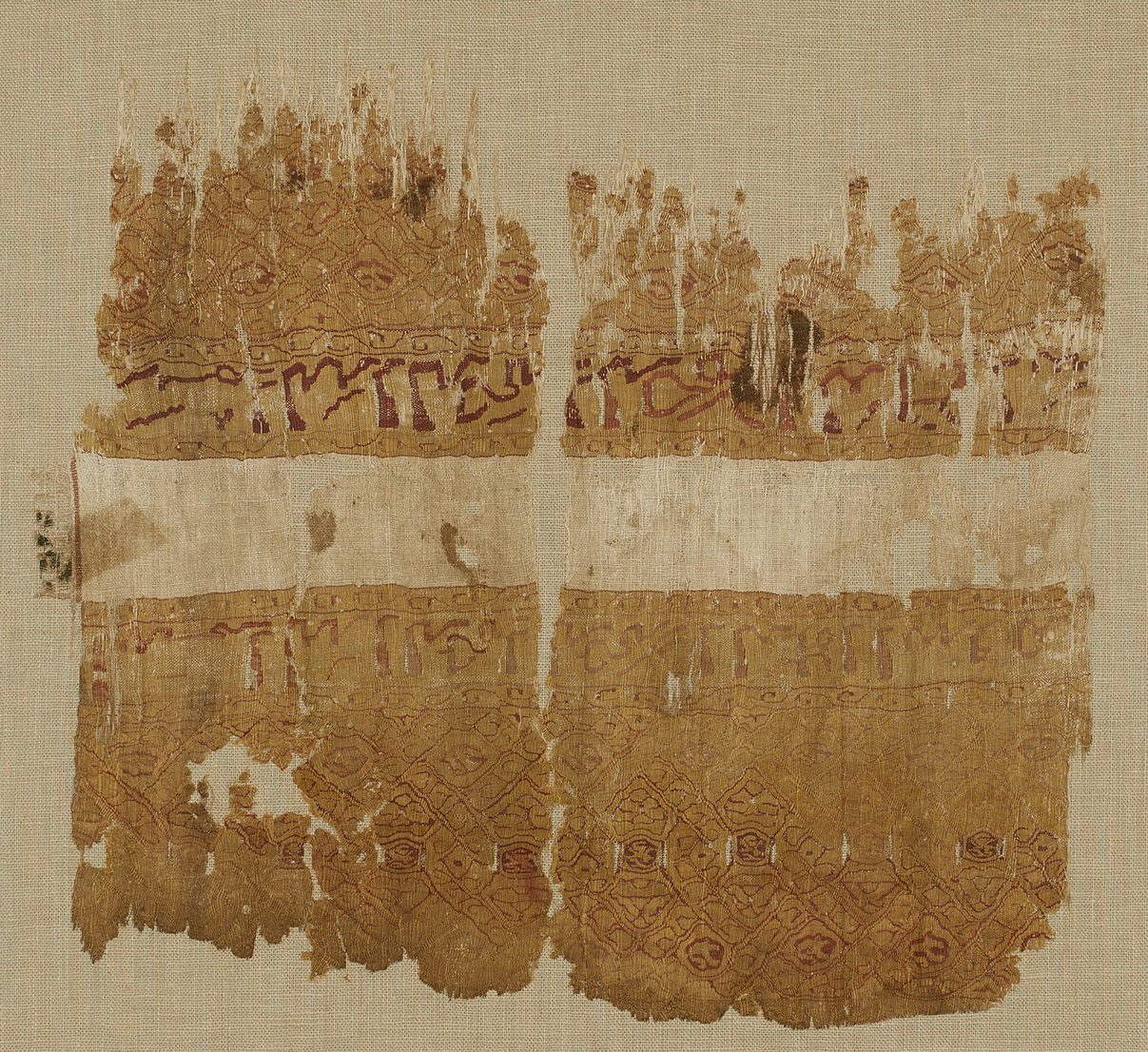Click on the image to zoom
Tiraz textile with wide tapestry-woven decorative bands
- Accession Number:AKM304
- Place:Egypt
- Dimensions:25 x 27.5 cm
- Date:mid-12th century
- Materials and Technique:linen tabby; with red and yellow silk tapestry-woven bands
The term “tiraz” actually means “embroidery,” but came to denote an inscription band as one sees on this textile and on anything else, including architecture. Tiraz textiles were popular in Egypt during the majority of the Fatimid period (909–1171). During the 12th century, Egypt no longer produced tiraz textiles that bore the caliph’s name. Instead, large swaths of tapestry-woven decoration appeared at the ends of the cloth. In these were embedded lines of calligraphy, conveying generic good wishes. Often just a few words were repeated across the width of the fabric. These attractive decorative bands displaced in importance the carefully designed epigraphic bands of earlier decades.
Further Reading
Not only did the weavers move away from inscribing with caliphal inscriptions that could be attributed to a specific ruler. They also executed the generic phrases in cursive rather than the monumental Kufic script. What motivated this shift remains to be determined, though it is certainly true that caliphal power was in decline; perhaps the name of the Fatimid caliph did not carry the same prestige as before. Also, the output of the tiraz workshops may no longer have been under the exclusive control of the ruler. Moreover, the large area given over to brightly coloured tapestry-woven decoration may have been more appealing than a single band of calligraphy written in archaic Kufic script. In all of the arts at this time, cursive script had begun to replace Kufic, making it easier to read inscriptions of every kind.
This fragment from the Aga Khan Museum Collection is typical of 12th-century Fatimid tiraz in its use of a rope-like trellis pattern containing small medallions with the figure of a hare or a bird that forms the ground of the decorative swaths. On this example, the hares are barely identifiable (upper row of medallions, on red ground), and the birds in the band above the inscription are far from their models.
A comparable textile in the Royal Ontario Museum has two swaths of tapestry-woven decoration, each with inscriptions on its borders, separated by a small area of undyed linen tabby. Many examples exist in other collections. [1] In the example from the Aga Khan Museum Collection, only the bottom inscription of the upper swath and the top band of the lower swath have been preserved. Each inscription ribbon is edged by a narrow scroll border.
The right side of the fragment appears to be a selvage (the edge that prevents the textile from unraveling) with a red stripe. This is also suggested by the fact that the beginning of the inscription has been preserved, as it starts with the traditional words, bismillah, followed by the declaration of the Faith. The inscriptions are tapestry-woven with red silk floss.
Inscriptions:
بسم الله الرحمن الرحيم لا اله الا الله وحده
Translation:
In the name of God, the Beneficent, the Merciful, there is no God but Allah alone . . .
Both inscriptions have the same wording, and their script is poorly executed. The lower inscription seems to be less carefully done.
— Lisa Golombek
Notes
[1] L. Golombek and V. Gervers, “Tiraz Fabrics in the Royal Ontario Museum.” In V. Gervers, Studies in Textile History in Memory of Harold B. Burnham (Toronto: Royal Ontario Museum, 1977), 116 (ROM 970.117.5); K. Otavsky and M.A.M. Salim, Mittelalterliche Textilien (Riggisberg, Switzerland: Abegg-Stifftung, 1995), no. 14, 45; Tissus d’Egypte: Témoins du monde arabe viiie–xve siècles: Collection Bouvier (Geneva: Musée d'art et d'histoire, Genève, 1993), no. 151, 250–5.
References
Golombek, L and V. Gervers, Studies in Textile History in Memory of Harold B. Burnham. Toronto: Royal Ontario Museum, 1977. ISBN: 978-0888541925
Otavsky, K and M.A.M. Salim, Mittelalterliche Textilien. Riggisberg, Switzerland: Abegg-Stifftung, 1995. ISBN: 9783905014068
Tissus d’Egypte: Témoins du monde arabe viiie–xve siècles: Collection Bouvier. Geneva: Musée d'art et d'histoire, Genève, 1993. ISBN: 9782908528527
Note: This online resource is reviewed and updated on an ongoing basis. We are committed to improving this information and will revise and update knowledge about this object as it becomes available.


